Riley Bailey
Ukraine’s liberation of Klishchiivka and Andriivka south of Bakhmut may have degraded the Russian defense in the area south of Bakhmut and could have rendered combat ineffective as many as three Russian brigades according to Ukrainian military officials. Ukrainian Ground Forces Commander Colonel General Oleksandr Syrskyi stated on September 18 that Klishchiivka (7km southwest of Bakhmut) and Andriivka (10km southwest of Bakhmut) were important elements of the Russian Bakhmut-Horlivka defensive line that Ukrainian forces “breached.”[1] Ukrainian Eastern Group of Forces Spokesperson Captain Ilya Yevlash stated on September 17 that Ukraine’s liberation of Klishchiivka will allow Ukrainian forces to control Russian ground lines of communication (GLOCs) supplying the Russian force grouping in the Bakhmut area — likely referring to Ukrainian forces’ ability to establish fire control over the T0513 Bakhmut-Horlivka highway.[2] ISW is currently unable independently to evaluate the strength and extent of the Russian defensive fortifications in the Bakhmut area, although Russian forces have likely fortified their defense lines near Bakhmut less heavily than they did in southern Ukraine. Russian forces south of Bakhmut are also likely battle-weary from the recent efforts to hold Klishchiivka and Andriivka, and the Ukrainian capture of two settlements defending a key Russian GLOC supporting Bakhmut indicates that these forces will likely struggle to replenish their combat strength and defend against any further Ukrainian offensive activity south of Bakhmut. There are no immediate indications that the liberation of Klishchiivka and Andriivka will portend a higher rate of Ukrainian advance south of Bakhmut, however, and the Russian defense of positions west of the T0513 will likely continue to present challenges for Ukrainian forces in the area.
The Ukrainian liberation of two villages that Russian forces were fighting hard to hold could correspond with the severe degradation of the Russian units defending them, as Ukrainian advances in western Zaporizhia Oblast appear to correspond with the significant degradation of defending Russian units and formations in that sector of the front. Russian forces defending in western Zaporizhia Oblast since the start of the counteroffensive have done so largely without operational-level unit rotations and have likely suffered compounding losses.[3] Elements of the Russian 42nd Motorized Rifle Division’s 71st, 70th, and 291st Motorized Rifle Regiments (58th Combined Arms Army, Southern Military District)routinely repelled Ukrainian assaults and engaged in various “combat clashes,“ including limited engagements and some counterattacks, during the first phase of the counteroffensive from June to August 2023.[4] In mid-to-late August, Ukrainian forces began breaking through the initial Russian defensive layer that these elements of the 42nd Motorized Rifle Division had spent considerable amounts of manpower, personnel, and effort to hold.[5] Russian reporting and footage suggest that many of these elements of the 42nd Motorized Rifle Division have since withdrawn to positions behind a subsequent Russian defensive layer between Verbove (18km southeast of Orikhiv) and Solodka Balka (20km south of Orikhiv) and now mainly shell advancing Ukrainian units.[6] The absence of recent reports and footage of these elements participating in combat engagements in western Zaporizhia Oblast suggests that casualties sustained during the first phases of the Ukrainian counteroffensive rendered them combat ineffective. Elements of the 70th Motorized Rifle Regiment reportedly temporarily withdrew to a rear area during the Ukrainian breakthrough and returned to frontline positions in early September, suggesting that Ukrainian advances had degraded this unit enough to compel the Russian command to give it time to refit in the rear — which would be one of the very few unit rotations ISW has observed on this sector of the front.[7] Elements of the 810th Naval Infantry Brigade (Black Sea Fleet), which also held forward positions at the initial Russian defensive layer during the earlier phases of the counteroffensive, similarly appear to be deployed further behind the Russian defensive layer ahead of the current Ukraine advance.[8] Elements of the 810th Naval Infantry Brigade reportedly engaged in close combat during the Ukrainian push through Robotyne (10km south of Orikhiv), and Russian milbloggers maintain that some elements of the unit hold positions near the southern outskirts of Robotyne.[9]
Ukrainian counteroffensive operations may have resulted in the particularly severe degradation of critical elements of the Russian elastic defense in western Zaporizhia Oblast. Elements of the Russian 22nd and 45th Separate Spetsnaz Brigades appeared to be responsible for counterattacking against significant Ukrainian advances in the Robotyne area during the earlier phases of the counteroffensive and likely suffered heavy losses in these operations.[10] Russian reporting and footage of the Robotyne area in recent weeks has largely omitted mention of these Spetsnaz brigades, suggesting that this degradation may have severely impacted their ability to continue counterattacking. A prominent milblogger claimed that elements of the 45th Spetsnaz Brigade were still operating near the frontline as of September 12, however.[11] Elements of the Russian 7th Guards Mountain Airborne (VDV) Division that laterally deployed to the Robotyne area in mid-August during the Ukrainian breakthrough now appear to be responsible for conducting counterattacks against the most forward advances of the Ukrainian breach.[12] Russian sources routinely claim that VDV elements, which may include elements of the 76th Guards VDV Division that also laterally redeployed to the area, repel Ukrainian assaults and conduct counterattacks near Robotyne[13] The degradation of the elements of the 22nd and 45th Separate Spetsnaz Brigades initially responsible for counterattacking in the Robotyne area likely prompted the Russian command to laterally redeploy these elements of the 7th and 76th VDV Divisions to assume responsibility for counterattacking. The Russian elastic defense requires one echelon of Russian forces to slow a Ukrainian tactical advance while a second echelon of forces rolls back that advance through counterattacking. Counterattacking requires significant morale and relatively high combat capabilities, and the Russian military appears to rely on relatively elite VDV units and formations for this undertaking, possibly at the expense of heavily degrading these forces.[14]
ISW has not directly observed the level of degradation among the Russian units referenced above and it is possible that some have suffered heavier losses than others. It is also possible that the Russians have used the arrival of elements of the 76th and 7th VDV Divisions to conduct belated unit rotations of their tired frontline units. The current battlefield geometry between the Ukrainian advance and current Russian defensive positions may also be contributing to the apparent absence of these likely degraded units from combat engagements, as the gap between Ukrainian advances and Russian defensive positions may result in less direct combat engagements. Ukrainian forces may engage these units in more direct combat as they further advance into and past the current Russian defensive layer. It is thus too soon to assess with high confidence that the initial defenders in this sector have been rendered combat ineffective, but the evidence currently available points in that direction.
Recent Ukrainian advances south of Bakhmut may correspond with the similar degradation of defending Russian units in the area. Syrskyi stated that Ukrainian forces completely destroyed the combat capabilities of elements of the 72nd Motorized Rifle Brigade (3rd Army Corps), the 31st Guards VDV Brigade, and the 83rd Guards VDV Brigade during the liberation of Andriivka and Klishchiivka.[15] Russian “Vostok” Battalion commander Alexander Khodakovsky’s claim that the 31st VDV Brigade commander has been killed supports this statement.[16] The 72nd Motorized Brigade has likely been rendered combat ineffective, although the exact level of losses among the two VDV brigades remains unclear.[17] These VDV elements were involved in counterattacking and attempting to roll back Ukrainian advances around Bakhmut — similar to the way that VDV elements operate in western Zaporizhia Oblast — and likely suffered heavy losses.[18] If recent Ukrainian advances south of Bakhmut resulted in the destruction of the 31st and 83rd VDV brigades’ combat capabilities, then the Russian command will likely laterally redeploy elements of another relatively elite formation to maintain critical elements of the Russian defense south of Bakhmut. Ukrainian counteroffensive operations have pinned elements of two VDV divisions and another VDV brigade in addition to the 83rd and 31st in the Bakhmut direction, and the Russian command may decide to conduct tactical redeployments to make up for the reported losses among the 83rd and 31st VDV brigades.[19] Lateral redeployments from elsewhere in Ukraine or substantial tactical redeployments of other VDV elements in the Bakhmut area would therefore indicate that recent Ukrainian advances have resulted in significant Russian losses.
Russian forces conducted a series of Shahed-131/136 drone and cruise missile strikes on coastal and rear areas of Ukraine on the night of September 17-18. Ukrainian officials reported that Russian forces launched 24 Shahed drones from Krasnodar Krai and occupied Crimea and 17 Kh-101/555/55 air-launched cruise missiles from Tu-95MS strategic bombers that took off from Volgograd Oblast.[20] Ukrainian officials reported that Ukrainian forces shot down 18 drones and all 17 missiles.[21] The Ukrainian Air Force noted that the Russian drone strike targeted Mykolaiv and Odesa oblasts.[22] Russian sources claimed that Russian drones hit ports in Odesa Oblast and that the Russian missiles targeted the Starokostyantyniv airfield in Khmelnytskyi Oblast.[23]
An organization with alleged ties to Russian First Deputy Presidential Chief of Staff Sergey Kiriyenko is reportedly responsible for disseminating pro-war propaganda and false information about Ukraine to prominent figures in the Russian information space. Russian opposition news outlets Meduza, Vazhnye Istorii, and the Bell reported on September 13 that the non-profit organization “Dialog” created multiple popular Telegram channels to increase pro-Russian reporting on the war in Ukraine at the start of Russia’s full-scale invasion and has subsequently been distributing false information about the war in Ukraine to prominent figures in the Russian information space, including Kremlin propagandist Vladimir Solovyov, prominent milbloggers, and popular news aggregators.[24] Dialog is also reportedly affiliated with pro-Russian Telegram channels that mimic Ukrainian channels.[25] Dialog reportedly advised unspecified individuals in the Russian Ministry of Defense (MoD) to issue a “tough” and “prompt” response following increasing reports of a lack of ammunition and provisions among Russian mobilized personnel in Ukraine.[26] Dialog-affiliated sources also reportedly disseminated negative reports about deceased Wagner Group financier Yevgeny Prigozhin while Wagner forces were fighting in Ukraine.[27] The Russian Ministry of Digital Development reportedly transferred 6.5 billion rubles (about $67.7 million) to Dialog in 2022, and its deputy general director, Vladimir Tabak, reportedly has ties to Kiriyenko.[28] ISW has consistently observed some Russian sources making similar claims with similar language on the same days, which may suggest that some Russian sources receive information from the same source. Kiriyenko’s reported affiliation with Dialog is consistent with ISW’s assessment that some Russian siloviki and senior military commanders control various Telegram channels intended to further their individual objectives in the Russian information space.[29]
Russian Minister of Foreign Affairs Sergey Lavrov met with Chinese Foreign Minister Wang Yi in Moscow on September 18. Lavrov stated in his opening remarks that the world is undergoing “tectonic shifts” and reiterated boilerplate rhetoric on the importance and previous successes of Russian-Chinese cooperation.[30]
Imprisoned ardent nationalist and former Russian officer Igor Girkin issued a direct criticism of Russian President Vladimir Putin to rally supporters to his cause. Girkin, via his lawyer Alexander Molokhov, posted a statement on September 18 dated September 15 that justifies Girkin’s opposition to Putin.[31] Girkin humorously answered the question “why Strelkov [Girkin] has gone crazy” for asserting that he is “better than Putin.” Girkin claimed that the “Troubles” (likely referencing the Time of Troubles in 17th century Russia that preceded the rise of the Romanov dynasty) have begun in Russia and that the Kremlin’s attempts to address the direst issues have failed, so the current “bureaucratic-oligarchic system” will eventually “collapse.” Girkin claimed that it is his “duty” to try to unite other patriots to be a suitable alternative but acknowledged that he may lack the resources to succeed or may have begun his initiative too early. Girkin expressed hope that his efforts will inspire others to “act as leaders of the national-patriotic movement” because “it is too late to be afraid and wait” as it is the “eve of the collapse of Russian statehood.”
Key Takeaways:
- Ukraine’s liberation of Klishchiivka and Andriivka south of Bakhmut may have degraded the Russian defense in the area south of Bakhmut and could have rendered combat ineffective as many as three Russian brigades according to Ukrainian military officials.
- Ukrainian counteroffensive operations may have resulted in the particularly severe degradation of critical elements of the Russian elastic defense in western Zaporizhia Oblast.
- Recent Ukrainian advances south of Bakhmut may correspond with the similar degradation of defending Russian units in the area.
- Russian forces conducted a series of Shahed-131/136 drone and cruise missile strikes on coastal and rear areas of Ukraine on the night of September 17-18.
- An organization with alleged ties to Russian First Deputy Presidential Chief of Staff Sergey Kiriyenko is reportedly responsible for disseminating pro-war propaganda and false information about Ukraine to prominent figures in the Russian information space.
- Russian forces conducted offensive operations along the Kupyansk-Svatove-Kreminna line, near Bakhmut, along the Avdiivka-Donetsk City line, in the Donetsk-Zaporizhia Oblast border area, and in western Zaporizhia and advanced in some areas on September 18.
- Ukrainian forces conducted offensive operations in at least two sectors of the front and advanced in western Zaporizhia on September 18.
- Some Russian sources claimed that former Wagner Group personnel are working closely with Rosgvardia (Russian National Guard) in order to return fighting in Ukraine.
We do not report in detail on Russian war crimes because these activities are well-covered in Western media and do not directly affect the military operations we are assessing and forecasting. We will continue to evaluate and report on the effects of these criminal activities on the Ukrainian military and the Ukrainian population and specifically on combat in Ukrainian urban areas. We utterly condemn these Russian violations of the laws of armed conflict, Geneva Conventions, and humanity even though we do not describe them in these reports.
- Russian Main Effort – Eastern Ukraine (comprised of two subordinate main efforts)
- Russian Subordinate Main Effort #1 – Capture the remainder of Luhansk Oblast and push westward into eastern Kharkiv Oblast and encircle northern Donetsk Oblast
- Russian Subordinate Main Effort #2 – Capture the entirety of Donetsk Oblast
- Russian Supporting Effort – Southern Axis
- Russian Mobilization and Force Generation Efforts
- Activities in Russian-occupied areas
Russian Main Effort – Eastern Ukraine
Russian Subordinate Main Effort #1 – Luhansk Oblast (Russian objective: Capture the remainder of Luhansk Oblast and push westward into eastern Kharkiv Oblast and northern Donetsk Oblast)
Russian forces continued limited ground attacks along the Kupyansk-Svatove-Kreminna line on September 18 but did not make any confirmed gains. Former Ukranian Deputy Defense Minister Hanna Malyar stated that Ukrainian forces repelled Russian attacks near Novoselivske (15km northwest of Svatove).[32] Ukrainian Eastern Group of Forces Spokesperson Captain Ilya Yevlash stated that Russian forces have slowed their offensive activity in the Kupyansk direction.[33] Malyar stated that Russian forces conducted no assault operations near Kreminna and continued to regroup in the area.[34] Ukrainian Main Military Intelligence Directorate (GUR) Head Kyrylo Budanov stated that Russian forces deployed elements of the newly created 25th Combined Arms Army (CAA) to the Kupyansk-Svatove-Kreminna line with 80 percent of its planned manpower and only 50 percent of the necessary equipment, supporting ISW’s assessment that the 25th CAA is likely combat ineffective due to its rushed deployment.[35] A Russian milblogger claimed that Russian forces made unspecified gains west of Svatove in the direction of the Oskil River and that fighting continued near Synkivka (9km northeast of Kupyansk) and in the direction of Petropavlivka (7km east of Kupyansk) on September 17.[36]
Russian sources claimed that Ukrainian forces conducted unsuccessful ground attacks in the Kreminna area on September 18. The Russian MoD claimed that elements of the Russian Central Grouping of Forces repelled two Ukrainian assaults near Dibrova (7km southwest of Kreminna) and the Serebryanske forest area south of Kreminna.[37] Russian Central Grouping of Forces Spokesperson Alexander Savchuk claimed that Russian forces also repelled a Ukrainian assault near Torske (17km west of Kreminna).[38]
Russian Subordinate Main Effort #2 – Donetsk Oblast (Russian objective: Capture the entirety of Donetsk Oblast, the claimed territory of Russia’s proxies in Donbas)
Ukrainian forces continued offensive operations in the Bakhmut area on September 18 and reportedly advanced. Ukrainian Eastern Group of Forces Spokesperson Captain Ilya Yevlash stated that Ukrainian forces achieved unspecified success in the Klishchiivka (7km southwest of Bakhmut), Bakhmut, and Predtechyne (12km southwest of Bakhmut) directions, and near Andriivka (9km southwest of Bakhmut), Kurdyumivka (12km south of Bakhmut), Bila Hora (12km southwest of Bakhmut), and Opytne (3km southwest of Bakhmut), likely referring to broad tactical directions.[39] Former Ukrainian Deputy Defense Minister Hanna Malyar stated that Ukrainian forces recaptured 5.1 square kilometers of territory in the Bakhmut direction in the past week.[40] The Ukrainian General Staff reported that Ukrainian forces continued assault operations near Klishchiivka[41] Yevlash stated that Ukrainian forces continue efforts to consolidate positions in Klishchiivka and that fighting continues near the railway line east of the settlement.[42] Russian milbloggers continued to claim that Ukrainian forces do not completely control Klishchiivka, claiming instead that the northern part of the settlement remains a contested “gray zone” after Russian forces withdrew from the settlement.[43] Russian milbloggers claimed that heavy fighting is ongoing along the Kurdyumivka-Andriivka-Klishchiivka line, in nearby forest areas, and near the railway line to the east.[44] A Russian milblogger claimed that Ukrainian forces also attacked near Dubovo-Vasylivka (6km northwest of Bakhmut).[45] The Russian MoD claimed that Russian forces repelled Ukrainian assaults near Vesele (20km northeast of Bakhmut), Klishchiivka, and Mayorske (20km southwest of Bakhmut).[46] Another Russian milblogger posted footage of unspecified elements of the Russian 106th Airborne (VDV) Division operating near Bakhmut on September 18.[47]
Russian forces continued to counterattack near Bakhmut and reportedly advanced on September 18. Russian milbloggers claimed that Russian forces recaptured some Ukrainian positions in northeastern Klishchiivka during counterattacks, but ISW has not observed visual confirmation of these claims.[48] The Ukrainian General Staff reported that Ukrainian forces repelled Russian attacks near Bila Hora, Klishchiivka, and Andriivka.[49] Former Ukrainian Deputy Defense Minister Hanna Malyar reported that Russian forces unsuccessfully tried to break through Ukrainian positions near Orikhovo-Vasylivka (11km northwest of Bakhmut), Bohdanivka (5km northwest of Bakhmut), Klishchiivka, and Kurdyumivka.[50]
Russian forces continued ground attacks on the Avdiivka-Donetsk City line on September 18 and marginally advanced. Geolocated footage published on September 18 shows that Russian forces marginally advanced north of Avdiivka.[51] Malyar stated that Russian forces conducted unsuccessful offensive actions near Keramik (14km northwest of Avdiivka), Avdiivka, Sieverne (11km southwest of Avdiivka), Marinka (27km southwest of Avdiivka), and Novomykhailivka (36km southwest of Avdiivka).[52] A Russian news aggregator claimed that fighting was ongoing near Opytne (4km south of Avdiivka) on September 17.[53]
The Russian MoD claimed that Russian forces repelled Ukrainian assaults near Marinka and Vodyane (7km southwest of Avdiivka) on the Avdiivka-Donetsk City line on September 18.[54]
Russian Supporting Effort – Southern Axis (Russian objective: Maintain frontline positions and secure rear areas against Ukrainian strikes)
Ukrainian forces conducted offensive operations in the western Donetsk-eastern Zaporizhia Oblast border area but did not advance on September 18. The Ukrainian General Staff reported that Ukrainian forces conducted assaults in the Shakhtarske direction, presumably referring to the Donetsk-Zaporizhia Oblast border area.[55] Russian sources claimed that Ukrainian forces unsuccessfully attacked near Urozhaine (9km south of Velyka Novosilka), Staromayorske (9km south of Velyka Novosilka), and Novodonetske (12km southeast of Velyka Novosilka).[56]
Russian forces conducted offensive operations in the western Donetsk-eastern Zaporizhia Oblast border area on September 18 and reportedly recently advanced. A prominent Russian milblogger claimed on September 17 that Russian forces control Stepove (22km southwest of Velyka Novosilka), although ISW has not observed visual confirmation of this claim.[57] Former Ukrainian Deputy Defense Minister Hanna Malyar stated that Russian forces unsuccessfully attacked near Novodarivka (16km southwest of Velyka Novosilka).[58] Russian sources claimed that Russian forces attacked near Urozhaine and from Pryyutne (16km southwest of Velyka Novosilka) but did not specify an outcome.[59] A Russian milblogger claimed that elements of the Russian 37th Motorized Rifle Brigade (36th Combined Arms Army, Eastern Military District) and the 127th Motorized Rifle Division (5th Combined Arms Army, Eastern Military District) are operating east of Urozhaine and north of Pryyutne, respectively.[60]
Ukrainian forces conducted offensive operations in western Zaporizhia Oblast and advanced on September 18. Geolocated footage published on September 18 indicates that Ukrainian forces advanced west of Verbove (18km southeast of Orikhiv).[61] The Ukrainian General Staff and Malyar reported that Ukrainian forces continued offensive operations in the Melitopol (western Zaporizhia) direction where they pushed Russian forces out of unspecified positions.[62] Malyar stated that Ukrainian forces have liberated 5.2 square kilometers in the southern direction within the past week and achieved unspecified successes east and south of Robotyne (10km south of Orikhiv).[63] Russian sources claimed on September 17 and 18 that Ukrainian forces unsuccessfully attacked near Novoprokopivka (13km south of Orikhiv), Verbove, and Robotyne.[64]
Russian forces conducted offensive operations in western Zaporizhia but did not advance on September 18. The Ukrainian General Staff and Malyar reported that Russian forces unsuccessfully attacked near Novodanylivka (5km south of Orikhiv) and Robotyne.[65] A Russian milblogger claimed that Russian forces counterattacked west of Verbove but did not specify an outcome.[66] The United Kingdom Ministry of Defense (MoD) stated that at least five regiments from the Russian 7th and 76th Airborne (VDV) Divisions were redeployed to reinforce the 58th Combined Arms Army (Southern Military District) near Robotyne recently.[67] The UK MoD assessed that these relatively elite VDV units are highly likely under strength.[68] ISW has been reporting on the presence of three regiments of the 7th VDV Division and two regiments of the 76th VDV Division in this area for some time. A Russian milblogger claimed that elements of the Russian 1429th Motorized Rifle Regiment (58th Combined Arms Army, Southern Military District) are operating near Robotyne.[69]
A Ukrainian strike on September 13 significantly damaged a Russian cruise-missile capable submarine and has very likely rendered it hors de combat for the duration of this war. The Georgia-based Conflict Intelligence Team (CIT) posted photographs on September 18 indicating that the Ukrainian attack on the Rostov-on-Don Kilo-class submarine in occupied Sevastopol, Crimea on September 13 caused significant damage in two areas of the submarine.[70] CIT amplified an assessment that the Russian Navy will most likely remove the submarine from active duty until the end of the war in Ukraine given the extent of the damage. The Rostov-on-Don is one of four cruise missile capable submarines in Russia’s Black Sea Fleet.[71] CIT stated that repairing the Rostov-on-Don is theoretically possible but that it would be easier for Russia to build a new Kilo-class submarine instead of repairing the Rostov-on-Don.[72]
A Russian milblogger claimed that Ukrainian forces tried to land in occupied Crimea and simultaneously conducted a drone strike on the peninsula on September 17.[73] The milblogger claimed that Russian naval aviation stopped 14 Ukrainian boats headed towards Crimea from Vilkovo, Odesa Oblast, and damaged several of the vessels.[74] The milblogger claimed that Russian air defenses and electronic warfare shot down two Ukrainian drones over Cape Fiolent (11km southwest of Sevastopol), two near Belbek airfield (6km north of Sevastopol), and one over southwestern Sevastopol.[75] The milblogger claimed that Ukrainian forces have targeted Crimea almost every day for the past 10 days.[76]
Russian Mobilization and Force Generation Efforts (Russian objective: Expand combat power without conducting general mobilization)
Some Russian sources claimed that former Wagner Group personnel are working closely with Rosgvardia (Russian National Guard) in order to rejoin the hostilities in Ukraine. Russian sources claimed that unspecified Wagner commanders are in “the closest possible contact” with Rosgvardia and that unspecified actors reached an agreement that will allow Wagner fighters to return to fighting in Ukraine as a “separate unit.”[77] Russian authorities may have negotiated with Wagner personnel to rejoin hostilities in Ukraine through subordination or connection to Rosgvardia because many Wagner personnel refused to sign contracts with the Russian MoD.[78] ISW continues to assess that it is unlikely that the Kremlin will restore Wagner as a large-scale quasi-independent organization under a unified command independent of the Kremlin or Russian MoD, which is the only likely form in which Wagner personnel would present a significant threat to the Ukrainian military again.[79]
Russian State Duma Defense Committee Chairman Andrei Kartapolov claimed on September 16 that Russian authorities will not fine individuals for ignoring electronic summonses in the upcoming autumn 2023 conscription cycle.[80] Kartopolov claimed that Russian military authorities will use paper documents as the main method to notify individuals of conscription summonses and that electronic summonses are “additional.”[81] The Russian State Duma approved amendments in July to increase fines for non-compliance on military summonses, however.[82]
A Russian military court convicted a pregnant female Russian soldier for failing to go through the proper channels to receive a medical exemption for service during partial mobilization. Russian news outlet Kommersant reported on September 18 that the Vladikavkaz Garrison Military Court sentenced Corporal Madina Kabaloyeva to six years in a general regime colony for failing to appear for military service without a valid reason.[83] Kommersant reported that the medical company of Kabaloyeva’s military unit had issued a recommendation for her temporary release from military service due to her pregnancy and responsibility over another child, but that Kabaloyeva did not appear before her unit’s leadership and continued to receive the salary and benefits of an active-duty soldier without serving.[84] Kommersant reported that the court will likely defer Kabaloyeva’s sentence due to her child and pregnancy.[85]
Chinese export restrictions have reportedly led to interruptions in the supply of drones and drone parts to Russia. Kommersant reported that temporary Chinese export restrictions starting at the end of July have resulted in a shortage of drones weighing over four kilograms and drone components, including thermal imagers.[86] Kommersant also stated that Chinese drone sellers are trying to establish parallel imports through transit countries but noted that Kazakhstan recently tightened its import procedure.[87]
Activities in Russian-occupied areas (Russian objective: Consolidate administrative control of annexed areas; forcibly integrate Ukrainian citizens into Russian sociocultural, economic, military, and governance systems)
Russian federal subjects continue to expand their patronage networks in occupied Ukraine. The Kherson Oblast occupation administration reported on September 18 that the Kabardino-Balkaria Republic is constructing a new medical facility in occupied Mykhailivka, Skadovskyi Raion.[88] Zaporizhia Oblast occupation administration head Yevgeny Balitsky announced on September 18 that the Tver Oblast government provided Russian occupation authorities with timber for the construction of new Russian fortifications in occupied Zaporizhia Oblast.[89]
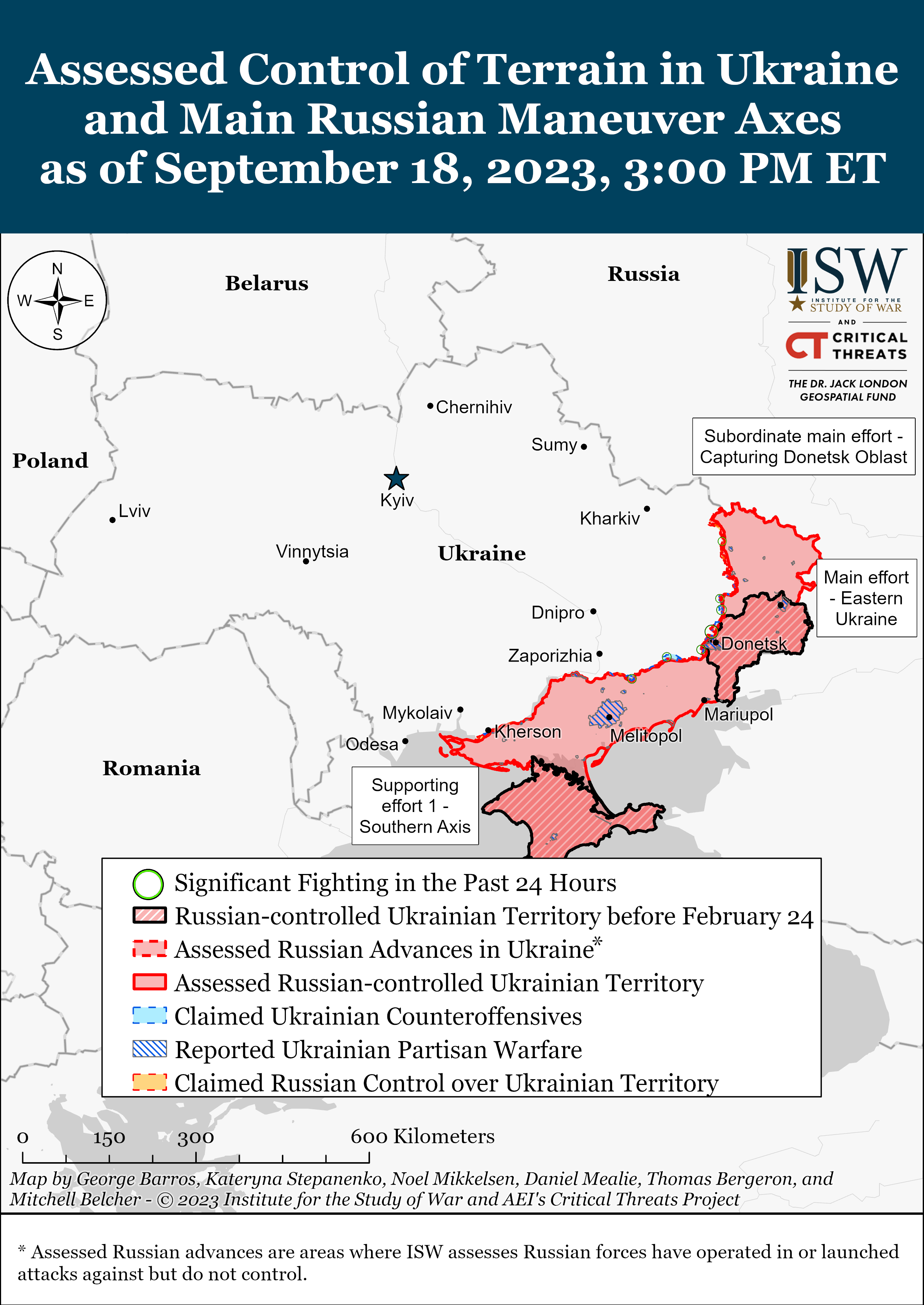
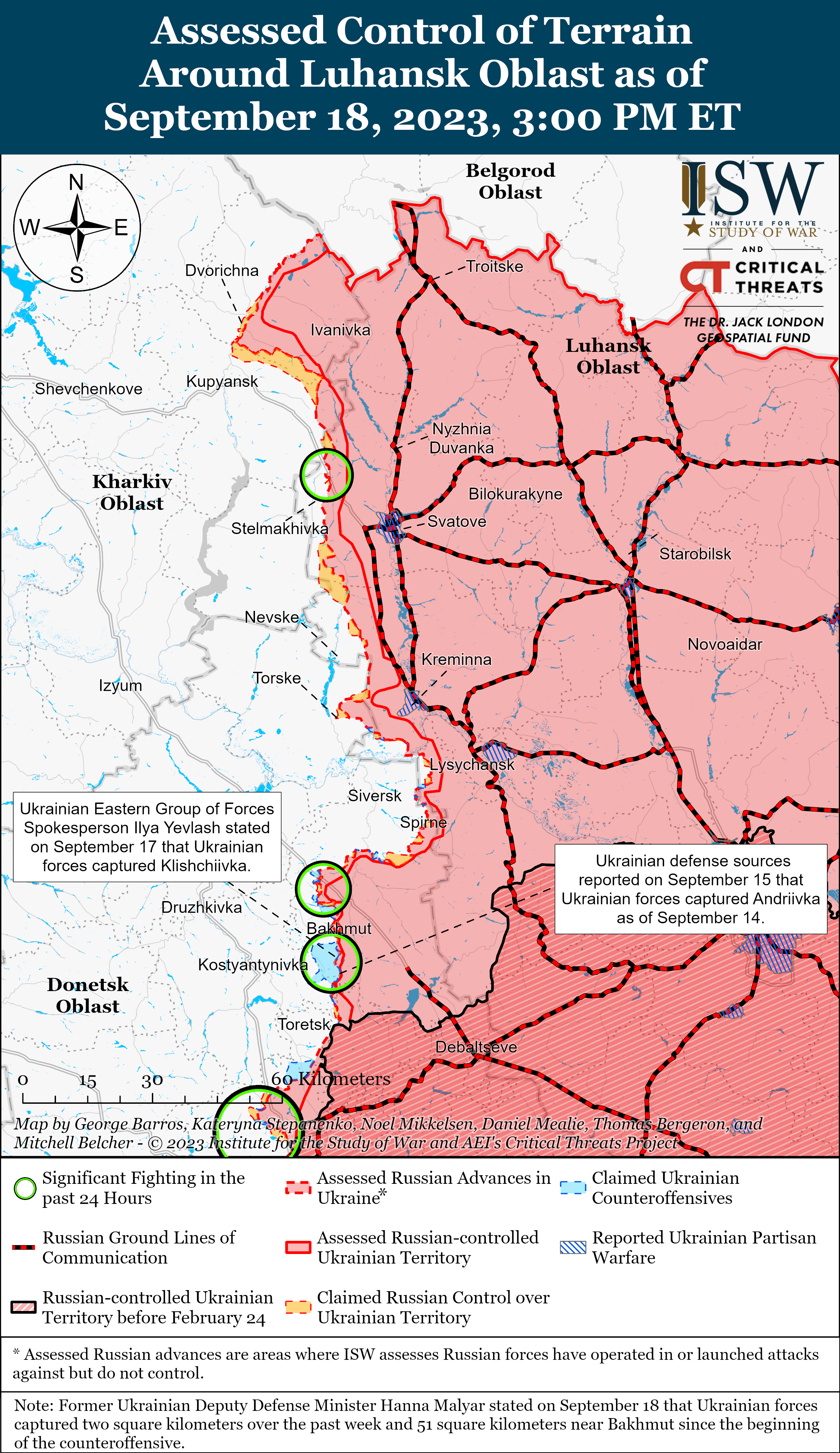
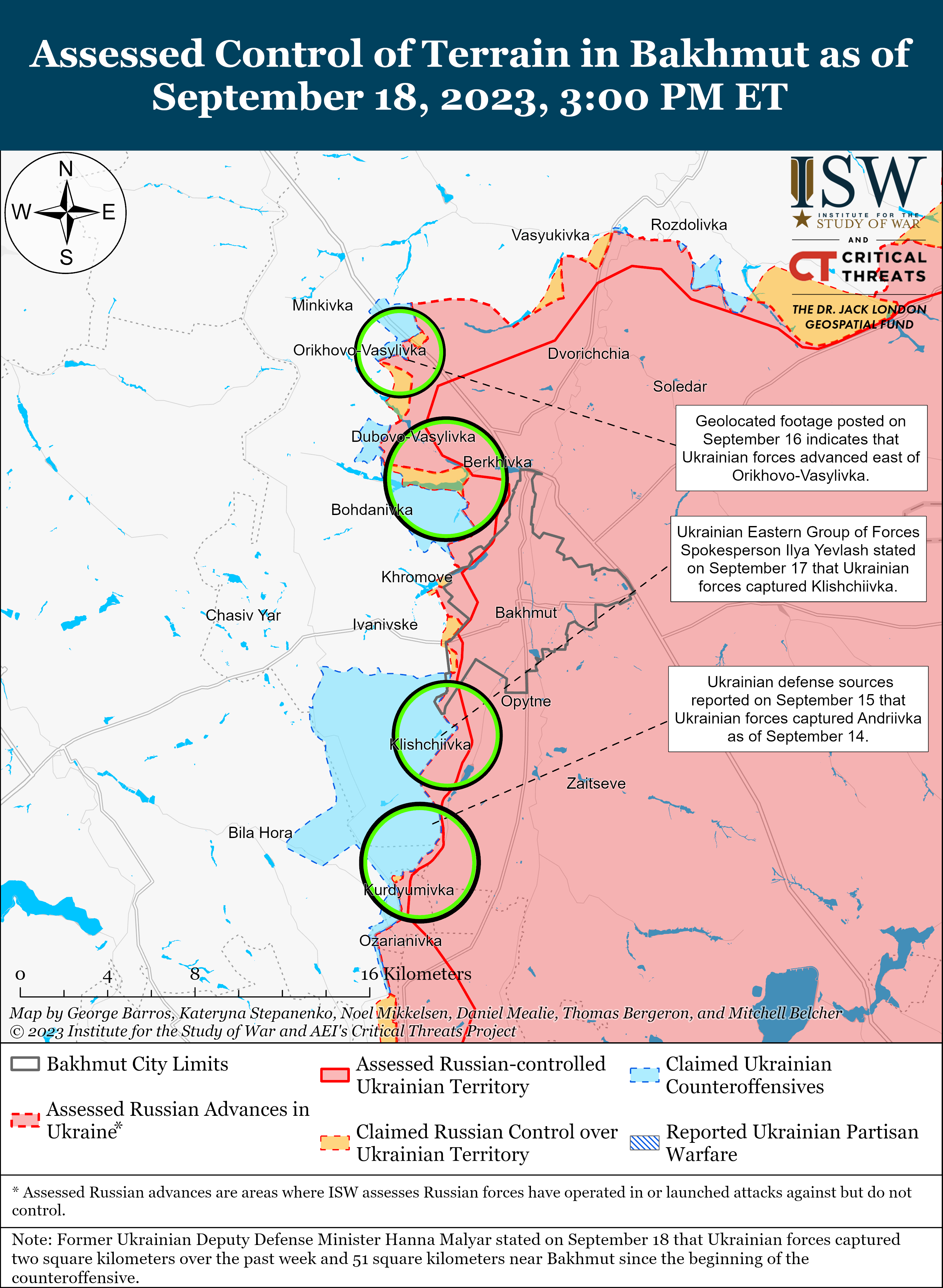
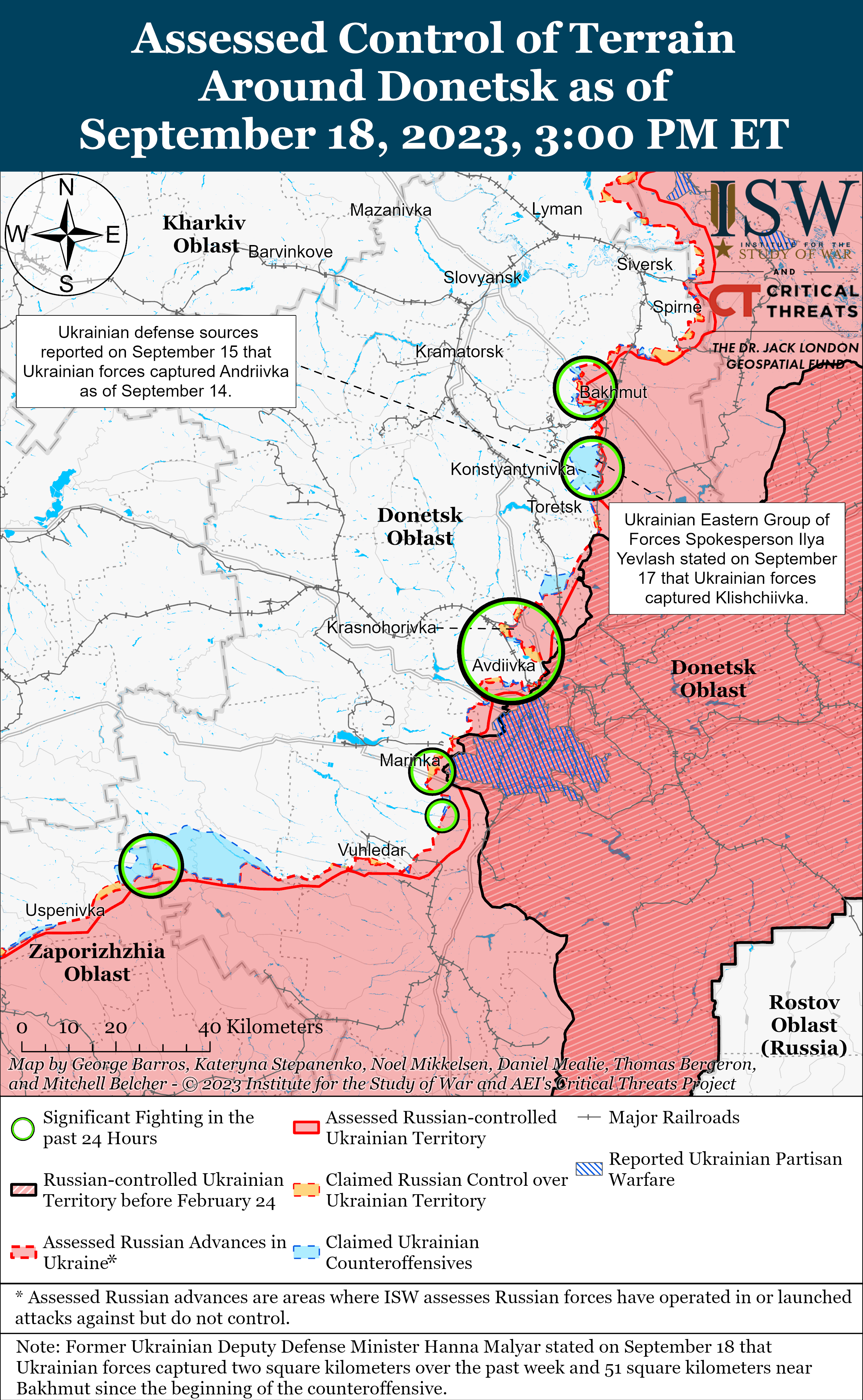
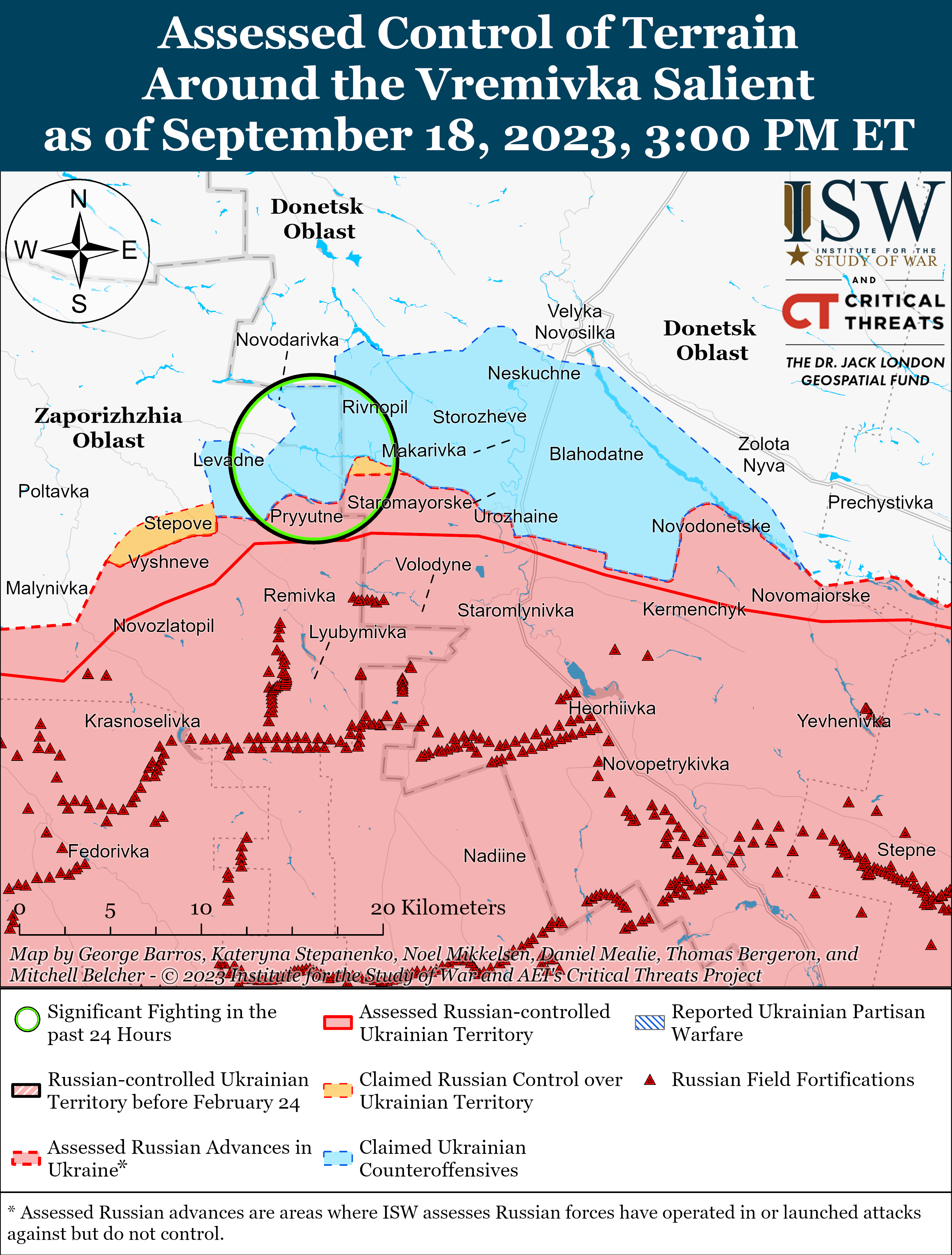
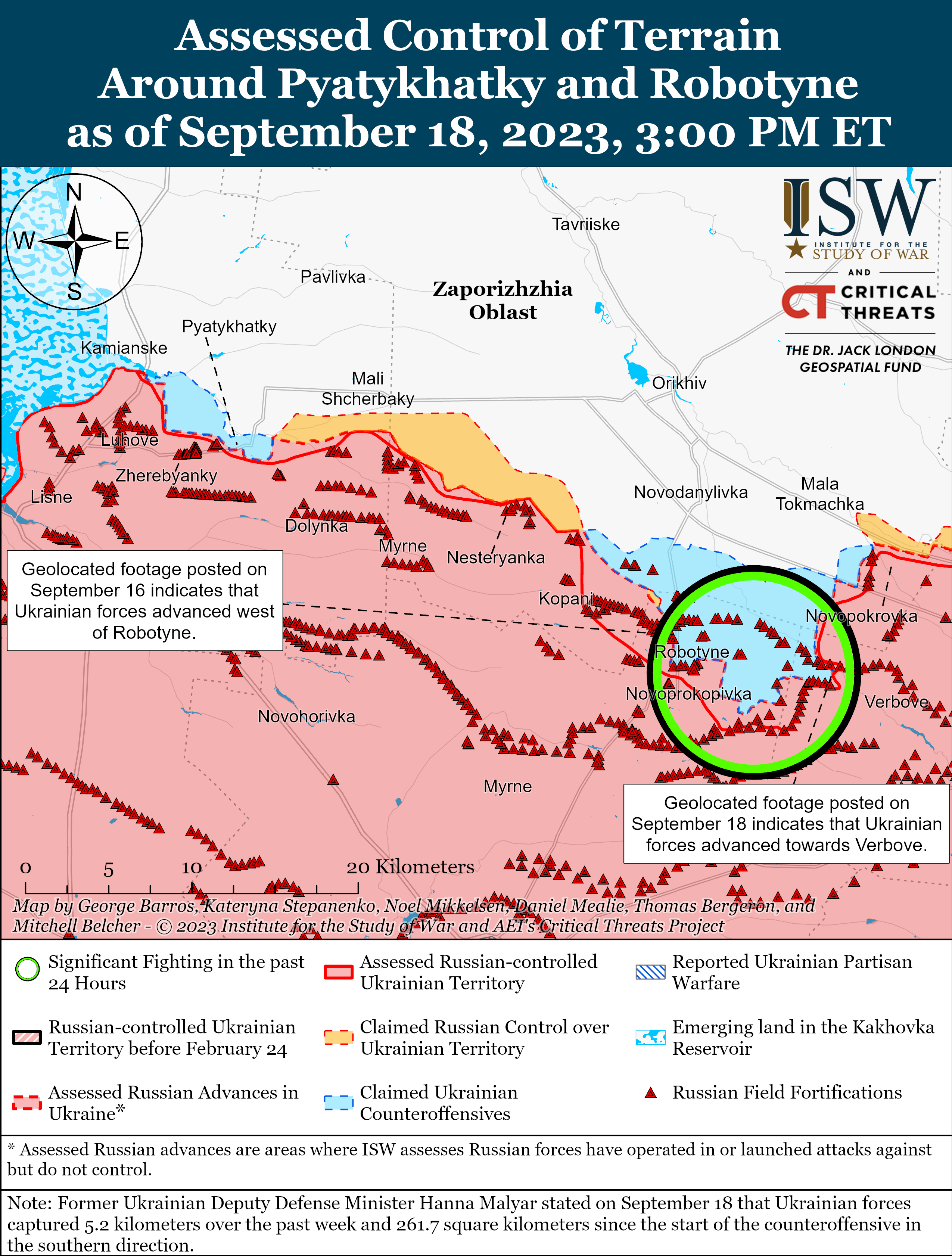
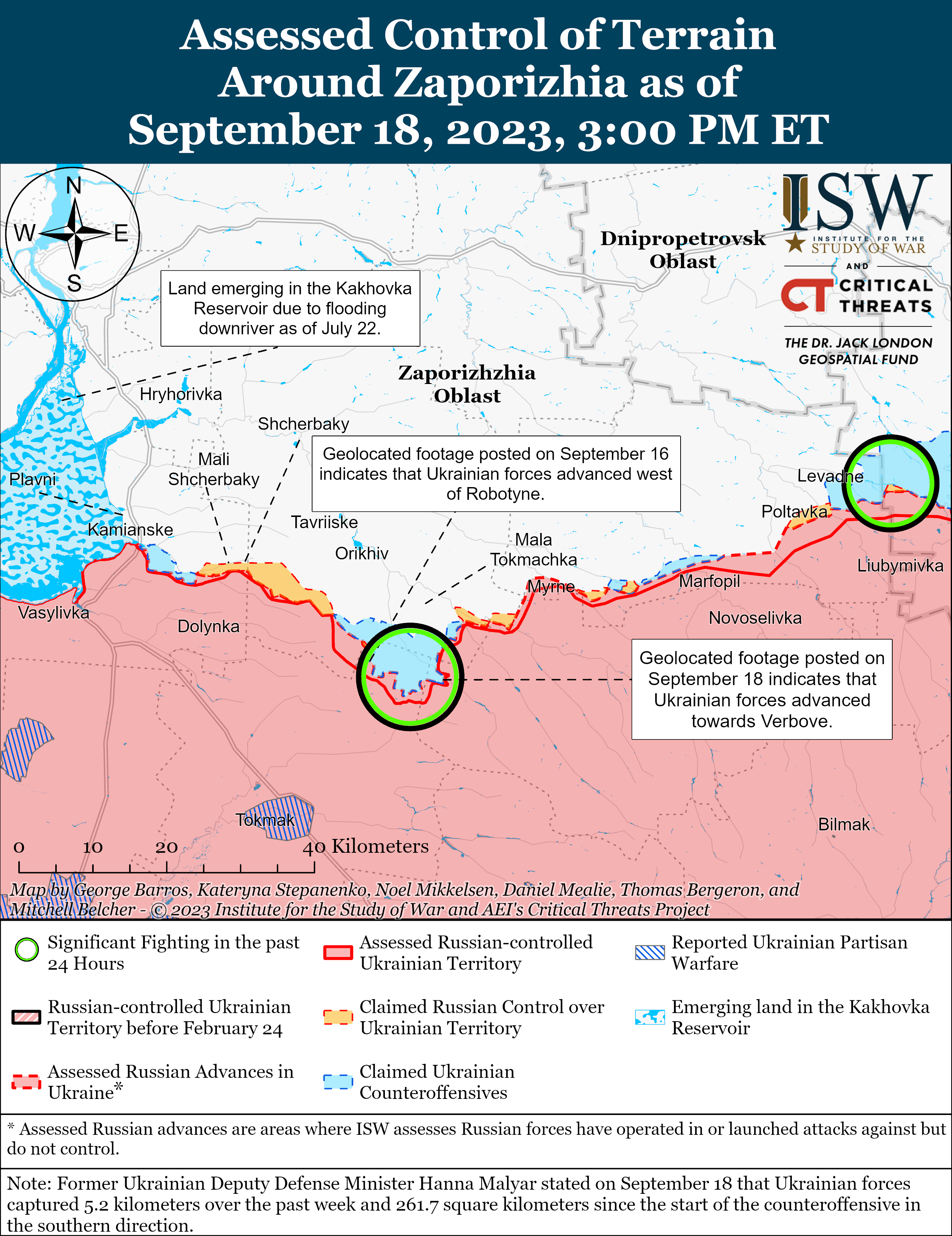
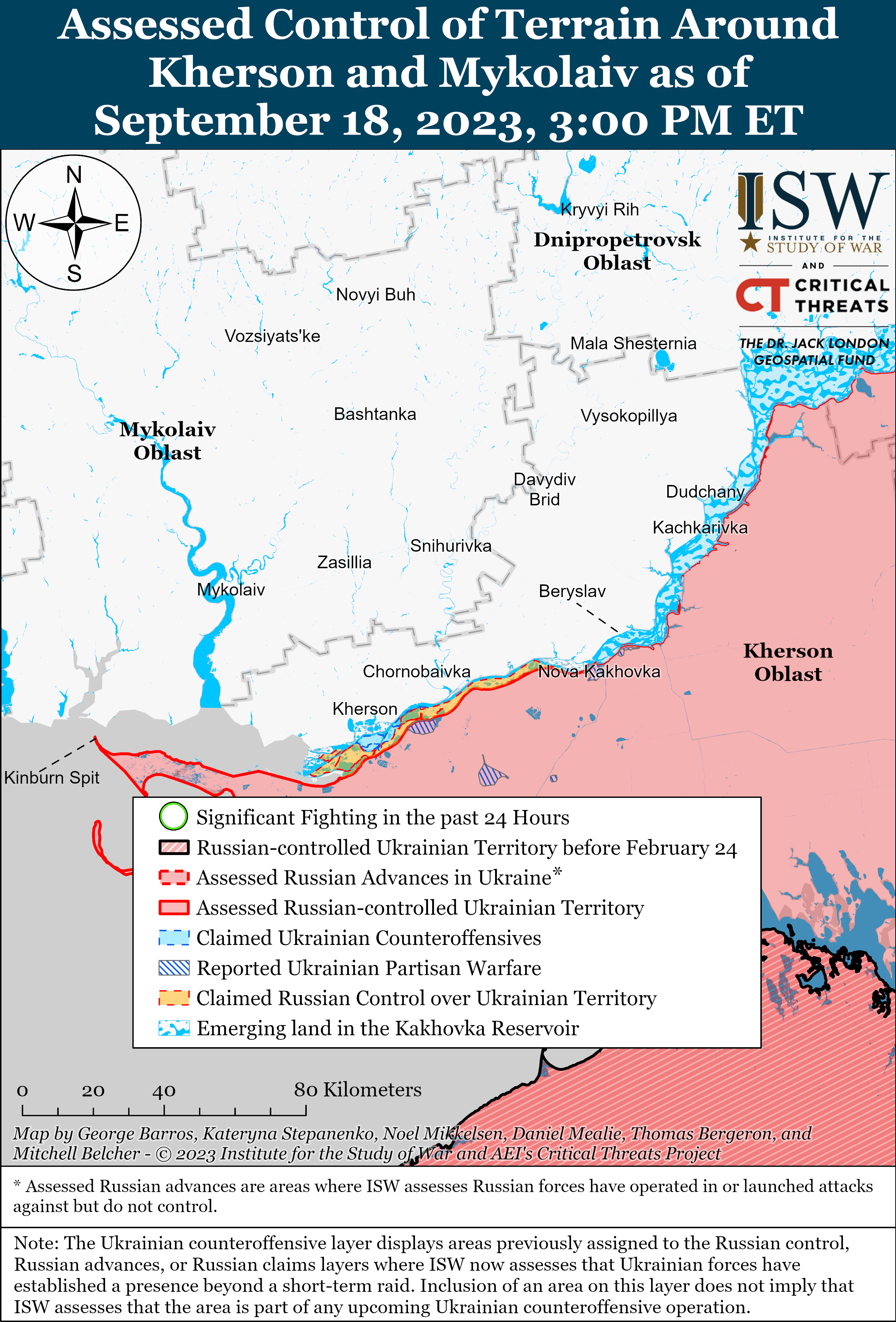
No comments:
Post a Comment